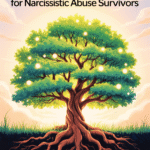Now Reading: How to Find the Right Therapist in New Orleans After Narcissistic Abuse
- 01
How to Find the Right Therapist in New Orleans After Narcissistic Abuse

How to Find the Right Therapist in New Orleans After Narcissistic Abuse
How to Find the Right Therapist in New Orleans After Narcissistic Abuse
Let’s begin with:

The Issue
How to Find the Right Therapist in New Orleans After Narcissistic Abuse
You survived psychological warfare. Not a “rough relationship.” Not “a few red flags.”
You lived through identity collapse, emotional hijacking, trauma bonding, and covert coercion from someone who used love as leverage and your nervous system as a battleground.
Now your recovery isn’t about venting.
It’s about reconstruction. Systemic. Tactical. Real.
That means your therapist can’t be a “good listener” with a couch and a clipboard.
You need someone trained in complex trauma, nervous system repair, and memory re-integration. You need a partner in your healing — not a passenger.
What to look for:
- Uses advanced trauma modalities: EMDR, Somatic Experiencing, IFS, Brainspotting — not just CBT or talk therapy.
- Helps rebuild your self-trust, not just manage symptoms.
- Offers flexible pacing and respects your timeline — not a 6-week boot camp.
- Supports your healing between sessions — with check-ins, worksheets, tools.
- Calls your trauma what it is — narcissistic abuse. No downplaying, no sugarcoating.
Anything less?
That’s just cozy conversation. You didn’t survive to “talk it out” and stay stuck. You’re here to take your life back.
🔷 10 Screening Questions to Vet Therapists in New Orleans — and Why They Matter
Let’s be clear: your trauma deserves precision, not politeness.
These aren’t “good to ask” questions. These are non-negotiable filters — forged from lived experience, designed to smoke out therapists who aren’t equipped to walk you out of the psychological war zone narcissistic abuse creates.
Ask them up front — in your discovery call, intake form, or initial email.
You’re not being difficult. You’re doing damage control before you hand your nervous system over to a stranger.
Each question includes why it matters — because you deserve to know the science behind your standards.
1. “Do you specialize in narcissistic abuse recovery?”
Why it matters: If they say “I treat all kinds of trauma,” press pause. Narcissistic abuse is specific. It requires an understanding of gaslighting, trauma bonding, chronic invalidation, and post-abuse fog.
Look for: “Yes, I have advanced training or lived experience in relational abuse.” Bonus: they use the term narcissistic abuse without flinching.
2. “What trauma modalities do you use — and why?”
Why it matters: You’re not looking for endless talk therapy. You need nervous system repair and memory re-integration.
Look for: EMDR, Brainspotting, IFS, Somatic Experiencing. If they can’t explain why they use what they use — they don’t know how it works.
3. “How do you support memory recovery and fog?”
Why it matters: Survivors often feel like they’re “losing their minds.” That’s gaslighting-induced memory disruption — not confusion.
Look for: validation of memory loss as trauma response, plus structured tools like journaling, guided imagery, or narrative reconstruction work.
4. “How do you handle clients who feel shame for ‘not leaving sooner’?”
Why it matters: Shame is one of the most corrosive side effects of abuse — especially when survivors blame themselves for staying.
Look for: “There’s no timeline for trauma. You did what you had to in order to survive.” If they say “Well, what kept you there?” — run.
5. “Do you believe all abusers are consciously malicious?”
Why it matters: This reveals whether they subtly excuse narcissistic behavior under the guise of empathy.
Look for: “Intent matters less than impact. Abuse is still abuse, even if it’s unconscious.” You don’t need someone defending your abuser’s childhood.
6. “What’s your approach when clients feel emotionally numb or shut down?”
Why it matters: Emotional numbing is not resistance — it’s survival. A trauma-aware therapist will recognize shutdown as protection, not avoidance.
Look for: somatic tools, window-of-tolerance language, and patience instead of pressure.
7. “Do you encourage clients to rebuild relationships with their abuser?”
Why it matters: Any therapist who casually recommends “reconnection” without understanding trauma bonds is not safe for you.
Look for: a No Contact–neutral or pro-boundary stance. Reconnection should never be assumed or encouraged until you feel ready — if ever.
8. “Do you offer between-session tools or support?”
Why it matters: Gaslighting survivors spiral in silence. You’ll need grounding techniques, journal prompts, and check-ins to stay regulated between sessions.
Look for: “Yes, I offer exercises, psychoeducation, or check-ins as needed.” Not just “We’ll talk about it next week.”
9. “Do you work with C-PTSD or emotional flashbacks?”
Why it matters: Many narcissistic abuse survivors experience Complex PTSD — with symptoms like shame spirals, sudden panic, and identity confusion.
Look for: “Yes, I recognize flashbacks can be emotional, not visual.” Ask if they use grounding tools or narrative interventions to help reconnect.
10. “What is your stance on diagnosing clients?”
Why it matters: You’re not broken. You’re reacting to sustained psychological trauma. Some survivors have been misdiagnosed with bipolar disorder or BPD after years of gaslighting.
Look for: “I diagnose cautiously, collaboratively, and in context of trauma history.”
💬 Final Word:
You’re not looking for a therapist to “fix” you. You’re looking for someone trained enough not to gaslight you again.
Print this list. Highlight your hard no’s. And if anyone gets defensive when you ask these questions? That’s your answer.
🧭 Trauma-Informed Providers in New Orleans
Here are therapists who meet your trauma standards—offering in-person and telehealth sessions:
🔹 Somatic & Nervous-System Experts
- Susan Pitler, LPC, SEP – Somatic Therapy of New Orleans Certified Somatic Experiencing for PTSD & narcissistic abuse
- Vin Lamia, LPC‑S Trauma therapist specializing in Narcissistic Personality Disorder and life transitions
🔹 EMDR + IFS Practitioners
- Keith Chazin, MSW, LCSW Uses EMDR and IFS tailored to survivors
- Laura Sullivan, LPC Certified EMDR therapist with 15+ years of experience
- Margaret Green, LPC, EMDR Trained in CBT, DBT, mindfulness, and EMDR; offers grief and trauma support groups
🔹 Brainspotting + Integrative Trauma
- Mehwish Issa, LCSW Brainspotting-certified, EMDR-trained, IFS Level 1 & 2
- Chelli Pumphrey, MA, LPC 30 years in trauma work; EMDR, Somatic Experiencing, IFS specialist
🔹 DBT & Emotional Regulation
- Rebecca Stephens, MS, LPC Offers DBT groups and individual counseling in Mobile, AL
🧠 Why These Modalities Matter
| Modality | Why It’s Essential |
|---|---|
| EMDR | Neurobiological trauma processing |
| Somatic Experiencing | Releases trauma in body/nervous system |
| IFS | Integrates fragmented self parts |
| Brainspotting | Targets deep-brain trauma nodes |
| DBT/CBT/Mindfulness | Builds emotional regulation and boundaries |
These aren’t buzzwords—they’re trauma realignment tools.
🔷 What Healing Actually Looks Like: Modalities That Work for Narcissistic Abuse Recovery
You don’t just need “someone to talk to.”
You need someone who can help you retrain your nervous system, restore your memory clarity, and untangle the trauma web you’ve been trapped in.
Narcissistic abuse doesn’t just wreck your emotions — it hijacks your body, your brain, your sense of self, and your ability to trust your own reality.
That’s why generic talk therapy (like CBT-only or “let’s vent about your week” sessions) often fails survivors of gaslighting and coercive control.
What you need is a therapist trained in modalities that get below the surface — into the somatic, neurological, and subconscious layers where the real damage (and real healing) happens.
Here’s what works — and why it matters.
🌀 1.
EMDR (Eye Movement Desensitization & Reprocessing)
This isn’t just about eye movements — it’s about reprocessing traumatic memories so they stop ambushing your body. EMDR targets the core memory clusters where pain and confusion live. It helps you unstick the frozen emotional reactions and safely rewire your brain’s associations.
Why it’s powerful for gaslighting survivors:
- You don’t have to “retell” every detail to heal it.
- It reduces emotional triggers without re-traumatizing.
- It helps separate truth from implanted lies — especially useful after memory distortion.
👉 Find a certified EMDR therapist at emdria.org
🧠 2.
IFS (Internal Family Systems Therapy)
Narcissistic abuse fractures your internal world. You end up with “parts” of yourself that are hypervigilant, ashamed, angry, or frozen — all fighting for control.
IFS helps you build a relationship with each of those parts, not suppress them. It treats your internal world with compassion, not correction.
Why it’s ideal for survivors:
- It addresses self-blame, shame spirals, and conflicting survival patterns.
- It helps you reconnect with your core “Self” — the version of you that trauma tried to silence.
IFS says: You are not broken. You are many. And all your parts deserve care.
🧍♀️ 3.
Somatic Experiencing (SE)
This approach views trauma as something trapped in the body, not just the mind. SE teaches you to track physical sensations (like tightness, heat, shakiness) and slowly release the energy stuck inside.
Why it’s a game changer:
- Helps with trauma-related body symptoms: insomnia, IBS, chronic fatigue, jaw tension
- Releases freeze response without forcing confrontation
- Helps rebuild trust in your body — especially after it’s been ignored or invalidated
You don’t talk your way out of trauma. You discharge it.
🎯 4.
Brainspotting
Think of it like EMDR’s sharper cousin. Brainspotting uses eye position and focused mindfulness to locate “trauma capsules” in the brain. The therapist watches your reflexes (blinks, fidgets, micro-movements) to help pinpoint where the trauma is stored.
Why it works:
- Perfect for survivors who feel blocked or can’t access emotions easily
- Doesn’t require verbal storytelling — works great for developmental or preverbal trauma
- Offers relief even when memories are foggy or scrambled (sound familiar?)
🗣️ 5.
Narrative Therapy
Gaslighting distorts your story. Narrative therapy helps you take it back.
This modality gives you space to rewrite your experience on your terms — with your language, your truth, and your own damn voice.
Why survivors need it:
- Helps reconnect with your sense of identity
- Externalizes the abuse instead of internalizing it
- Builds language and meaning around what happened — no more “I don’t know why I stayed.”
Your story was hijacked. This brings it home.
🛠️ 6.
Psychoeducation & Trauma-Informed Coaching
Sometimes, the most healing thing isn’t therapy — it’s understanding what the hell just happened to you.
Therapists and coaches who integrate psychoeducation teach you about:
- Trauma bonding
- C-PTSD
- Gaslighting tactics
- Fawn response
- Emotional flashbacks
- Dissociation
Knowledge doesn’t just give you insight — it gives you back your agency.
❌ What Doesn’t Work (And Might Hurt You More)
Let’s talk about the elephant in the waiting room:
❌
Talk therapy with no trauma framework
Just discussing your week with someone who isn’t trained in emotional abuse can re-traumatize you. Especially if they:
- Say things like “Did you try communicating more?”
- Ask why you stayed
- Push reconciliation without understanding trauma bonds
❌
Over-reliance on CBT
CBT is great for short-term symptom management — but it doesn’t touch the deeper identity erosion and somatic trauma that narcissistic abuse causes.
If your therapist only focuses on “reframing your thoughts,” but ignores the fact that you were systematically gaslit, that’s a red flag.
💬 Final Word:
Your healing isn’t optional. And it isn’t shallow. It’s structural.
Don’t settle for a therapist who doesn’t speak your language. You deserve someone who understands the nervous system effects of gaslighting, the dissociative fog of trauma, and the identity collapse that comes from chronic emotional abuse.
You’re not overreacting.
You’re recovering.
🔷 Local Therapists in New Orleans to Start With
Trauma‑Informed Practitioners for Narcissistic Abuse Recovery
1. Veronica Mollere, LCSW–BACS (Well Psychotherapy)
- Modalities: EMDR, Brainspotting, Clinical Hypnotherapy, Narrative Therapy
- Why she stands out: Trauma-informed, queer-affirming therapist specializing in relationship abuse, complex trauma, and dissociative layers. She explicitly names and treats narcissistic abuse.
- Location: Well Psychotherapy, 601 N. Carrollton Ave, New Orleans, LA 70119
- Consult: Free 15-minute intro
- Source & contact: Call (504) 285‑2626 or visit practice page 👉 Well Psychotherapy profile
2. Dr. Damekia Morgan, DSW, LCSW, BACS
- Modalities: EMDR, Brainspotting, Clinical Trauma Professional, C‑DBT
- Why she stands out: Combines trauma modalities with anxiety and stress focus—key for survivors managing emotional dysregulation post-gaslighting.
- Location: New Orleans, LA 70119
- Source & consult: Certified in EMDR and Brainspotting 👉 Psychology Today listing
3. Margaret Green, LPC, NCC
- Modalities: EMDR, Brainspotting, IFS, CBT, DBT, Mindfulness
- Why she stands out: Integrates trauma modalities under a neuroscientific lens; trauma-bonded survivors benefit from her structured weekend availability and free consults.
- Source & consult: Trained in EMDR & Brainspotting 👉 Psychology Today listing
4. Phillip Thomas Stepka, PsyD
- Modalities: Somatic Experiencing, Somatic-Nervous System Integration
- Why he stands out: Beyond talk therapy—focus is bodily regulation and nervous system rebalancing, vital for hypervigilance or shutdown.
- Location: Online & in‑office at 137 N Clark St, New Orleans, LA 70119
- Source & consult: 4.7★ rating, certified psychologist 👉 WebMD / Healthgrades profile
5. Susan Pitler, MS, LPC
- Modalities: EMDR, Somatic Experiencing, IFS, Psychodynamic Therapy
- Why she stands out: Specializes in healing attachment and relational trauma, with an earned reputation for supporting survivors of narcissistic abuse.
- Location: 641 Seguin Street, New Orleans, LA 70114; Phone: (504) 608‑1859
- Source & consult: Certified Somatic Experiencing Practitioner 👉 SusanPitler.com
6. Aaron Kapin, SEP (Somatic Experiencing Practitioner)
- Modalities: Somatic Experiencing (SEP), Somatic-informed bodywork
- Why he stands out: Ideal for survivors with chronic anxiety, stress, or trauma stuck in the body. Offers accessible online work and free consults.
- Source & consult: 16 years’ experience, Seattle-based with remote sessions 👉 SelfSpace Seattle profile
💡 Survivor-Centered Playbook
- Pick your starting point:
- EMDR/Brainspotting (Mollere, Morgan, Green) for memory and trauma ambush.
- Somatic work (Stepka, Pitler, Kapin) for bodily tension and regulation.
- IFS & EMDR combos (Green, Pitler) for identity fragmentation and self‑trust rebuilding.
- Schedule a free consult: Use your coaching “Screening Questions” list to verify trauma-fit and comfort with modality.
- Test the pacing: A trauma-informed therapist won’t rush. If they talk “fixing” or “90-day programs,” that’s a red flag.
💬 Survivor Tip from NOLA Reddit:
“I finally felt seen when my therapist said, ‘I believe your memory. I see the fog. We’ll unpack it together.’” – r/NewOrleans survivor
You’re not just choosing a therapist. You’re selecting someone to guide your clarity, courage, and comeback.
🔷 Peer Support & Community Resources in New Orleans
Survivor-Led Spaces for Emotional Reset, Validation & Collective Healing
Connecting with other survivors is critical for transferring trust—from your abuser to real people who see you, believe you, and reflect your reality back at you. These groups and resources are tailored for survivors of narcissistic, emotional, or relational abuse.
1.
Out of the FOG (Online Community)
- What it offers: Peer-moderated forums for those affected by narcissism, personality disorders, and emotional manipulation.
- Why it matters: You’ll hear survivors say things like “You didn’t cause it, you can’t cure it, and you can’t control it”—truth you might not hear anywhere else .
- Access: Completely free and anonymous. 👉 Visit OutoftheFOG.website
2.
NAMI Southeast Louisiana – Peer Support Groups
- What it offers: Free, peer-led mental health support groups for adults navigating trauma and emotional distress .
- Why it matters: These groups offer structured community support with shared experience—perfect for gaslighting survivors needing consistency and safe validation. 👉 Learn more at NAMI Southeast Louisiana
3.
Metropolitan Human Services District – Peer-Led Support
- What it offers: Local in-person peer groups (Central City, Algiers, New Orleans East, St. Bernard) focusing on trauma, mental health, and group processing .
- Why it matters: Survivors report peer-led environments reduce shame and increase trust in emotional expression. 👉 Details at MHS District Support Services
4.
Wandering Together: Outdoor Group Therapy
- What it offers: An 8-week, outdoors-based group, led by a licensed clinician with somatic integration and eco-arts therapy .
- Why it matters: Walking and nature-based group therapy helps regulate anxiety, nervous system overload, and cognitive fog—all prime symptoms after narcissistic abuse. 👉 Register via Crescent City Psychotherapy
5.
Intro to Somatics Group (Hosted by Rachele Thompson, LCSW)
- What it offers: 8-week small group (4 participants) introducing somatic tracking, psychoeducation, personalized goals, and nervous-system regulation .
- Why it matters: Designed specifically for trauma survivors—helps re-anchor in body awareness and reduce dissociative tendencies post-gaslighting. 👉 Join via Crescent City Psychotherapy
6.
Meetup: Narcissism Survivor Group
- What it offers: Peer meetup groups nationwide—with local chapters—in cities like NOLA .
- Why it matters: In-person or hybrid events offer direct community connection—crucial for learning strategies and rebuilding dignity in shared space. 👉 Search “Narcissism Survivor” on Meetup.com
7.
NAMI Family Support Group (Peer-Led)
- What it offers: Weekly group sessions for adults with mental health or emotional trauma experiences .
- Why it matters: Though not specifically gaslighting-focused, familiarity with group processing and non-judgmental listeners provides foundational community support. 👉 Register at NAMI Southeast Louisiana
💡 How to Use These Communities
- Start online: If trust is fragile, begin with forums like Out of the FOG—anonymous, always accessible.
- Move to hybrid: Join local NAMI or Meetup events when you’re ready for face-to-face validation.
- Try somatic groups: For trauma stored in your body, opt into outdoor therapy or Intro to Somatics.
- Protect your space: Gaslighting isolates—don’t let it isolate you from healing. Each group listed here is vetted to prioritize safety and survivor dignity.
💬 Survivor Insight:
“Hearing other women say ‘I felt foggy too’ out loud—that cracked open my shame cage.”
— Reminder from New Orleans meetup
Your recovery isn’t just personal—it’s political. Being seen in real circles of survivors dismantles the loneliness narcissists weaponize. These groups are your frontline allies.
🔷 Tactical Healing Steps for Post-Gaslighting Recovery
Reclaiming Clarity, Boundaries, and Your Peace—One Survivor-Tested Strategy at a Time
These tactical steps are survivor-proven, therapy-aligned, and built to reclaim your mind, body, and identity after narcissistic abuse.
1.
Create a Trauma Anchor Journal
- What to do: Carry a dedicated notebook or secure app and log small truths daily—conversations, feelings, flashes of clarity.
- Why it matters: Reinforces memory consistency and disrupts the gaslighting fog.
- Tactical note: Review entries weekly and highlight recurring themes—your truth becomes impossible to erase.
2.
Develop a Somatic Reset Routine
- What to do: Pick a daily ritual (breathing, grounding, gentle movement). Try 5-minute box breathing or a quick body scan before bed.
- Why it works: Regulates your nervous system, retrains trauma responses, and builds neural anchors for safety.
- Tactical tip: Tie the routine to a daily habit (e.g., after brushing your teeth) to embed consistency.
3.
Use Voice Memos for Reality-Testing
- What to do: Record snippets after triggering interactions. Notes don’t need to be eloquent—just raw, real, and real-time.
- Why it matters: Human memory is malleable under stress. Voice memos capture tone, emotion, and context for real.
- Tactical tip: Label by date and topic—“May 5_Root argument about finances”—so playback isn’t jumbled later.
4.
Practice Boundary Script Rehearsal
- What to do: Choose a boundary you need to assert (e.g., “We aren’t talking when I’m being yelled at”), and practice it out loud—or in the mirror.
- Why it works: Rehearsal builds muscle memory and confidence.
- Tactical tip: Record yourself and listen back—sound confident, steady, lived-in.
5.
Schedule Regular Safety Check-ins
- What to do: Every Sunday, text/call a trusted friend: “This week felt foggy/confusing. Did I zone out?”
- Why it matters: Community-based reality checks interrupt isolation and help you preserve clarity.
- Tactical tip: Keep it simple: “How did I come across this week?” or “Was I calm or reactive?”
6.
Choose One Somatic Therapy Technique
- What to do: Pick one somatic exercise—like shaking out your limbs, jumping in place, or belly breathing—and practice it for 2 minutes daily.
- Why it matters: Builds nervous system resilience in small, sustainable steps.
- Tactical tip: Use it before anxiety hits—like prepping for a tough conversation, not just after.
7.
Reflect Through Ego-State Exploration
- What to do: Use a prompt like “Who inside me is speaking when I say __?” (e.g., “I can’t handle this” or “I’m worthless”).
- Why it works: Helps you separate trauma-held “parts” (shame child, anxious teen) from your core Self.
- Tactical tip: Add it to your weekly journal check-in—write a one-sentence dialogue with that part.
8.
Build a Digital “Fog Shield” Toolkit
- What to include: Pre-scripted boundary statements, breathing tracks, journaling prompts, and emergency voice memos.
- Why it matters: When under mental attack, there’s no time to think—only to react. An organized toolkit gives you clarity on autopilot.
- Tactical tip: Store it in a folder labeled “SELF CARE” or “MY TRUTH” on your phone—always one tap away.
9.
Monitor Flashbacks & Emotional Triggers
- What to do: Use a simple tracker to log when sudden shame, rage, or panic hits—and what event triggered it (or if it felt unprompted).
- Why it matters: Flashbacks are trauma signaling. Tracking them means you can anticipate and disempower them with tools before they dominate your day.
- Tactical tip: Index them in your journal by emotional type—shame, fear, disconnection, etc.—and note what tool helped most.
10.
Celebrate Clarity Wins — No Matter How Small
- What to do: At the end of each week, list 3 ways you felt grounded, empowered, or confident.
- Why it matters: Gaslighting is designed to erase wins and rewrite your narrative. Celebrating small victories rebuilds trust in yourself.
- Tactical tip: Choose a reward—favorite podcast, tea ritual, 30-min walk—as reinforcement. You earned it.
💬 Final Word
These are more than coping strategies—they’re neuro-rewiring tools for reclaiming your sense of self after manipulation. Use them as your structural foundation for healing, and keep adding strength—day by day, step by step.
🔷 🚩 Red-Flags Watchlist: Signs You Might Still Be in a Manipulative Environment
After gaslighting, true safety isn’t automatic. The recovery journey includes recognizing when old patterns reappear—so you can protect your clarity and regain control. These red flags highlight relational toxicity and help you safeguard your boundaries and mental health.
1.
You’re Asked to Explain Your Feelings—Again and Again
What to watch for: Requests like “Just tell me why you’re upset” or “Explain it logically” during emotional moments.
➡️ Survivor insight: That’s a demand for justification, not understanding. Emotional transparency should never be weaponized.
2.
Someone Calls You “Too Sensitive” or “Reactive”
What to watch for: Disparaging your emotional response or gaslighting your emotional process.
➡️ Survivor insight: Emotional invalidation is the breeding ground of shame and self-blame.
3.
Your Memory Gets Questioned—Publicly or Privately
What to watch for: Comments like “You remembered that wrong” or “That never happened, we were just joking.”
➡️ Survivor insight: Repeated memory challenges are a classic gaslighting move—meant to fracture your trust in yourself, not build trust in the relationship.
4.
Conversations End with You Feeling Wrong
What to watch for: Arguments or clarifications that don’t resolve—only leave you feeling fuzzy, exhausted, or ashamed.
➡️ Survivor insight: That’s emotional manipulation, not healthy communication.
5.
Your Boundaries Are Treated as a Menu
What to watch for: You set a limit and it’s met with “I’ll do it this once, but…” or “Fine, but only because I love you.”
➡️ Survivor insight: Boundaries are non-negotiables, not invitations or conditional concessions.
6.
You’re Told to “Calm Down” or “Chill Out”
What to watch for: Emotional deflections that minimize your feelings and redirect the conversation.
➡️ Survivor insight: That phrase silences you—it’s not care, it’s control.
7.
They Reframe Your Experience (“You Misunderstood”)
What to watch for: Any version of “That’s not what I meant” or “You got it all wrong.”
➡️ Survivor insight: Gaslighting relies on confusion and shifting narratives. Your lived experience deserves stability, not chaos.
8.
They Monopolize Conflict Resolution
What to watch for: They decide when, where, or if a conflict is addressed, often deflecting or delaying until you drop it.
➡️ Survivor insight: Failing to honor your conflict readiness is a sign they control the emotional rhythm of the relationship—not you.
9.
You Feel Ignored, Even When You’re Speaking
What to watch for: Check their response: are they listening or just waiting to talk?
➡️ Survivor insight: Real listening validates your reality—even when it’s not theirs.
10.
You Frequently Question Their Intentions, Not Just Their Words
What to watch for: You find yourself asking, “Are they really trying to help—or just set me up to doubt myself?”
➡️ Survivor insight: That chronic distrust might be trauma reflex—but it could also be your protection alerting you to true toxicity.
✅ How to Use This Watchlist
- Highlight your current situation: Circle the top 3 flags that stand out.
- Rate each one on a scale of 1–5 (1 = occasional, 5 = daily).
- Set a boundary: Define what you need instead from that person (“I need you to let me speak without interruption”).
- Test it: Use your voice memo or journal after boundary work. How do you feel? Stayed tonally calm, or got manipulated again?
- Decide next step: Keep boundary, escalate to No Contact, or enlist help via therapy or survivor community.
💬 Survivor Tip:
“It wasn’t until I stopped accepting ‘calm down’ that I realized how deeply I’d been silenced.”
— Survivor, r/raisedbynarcissists
Note:
Recovery isn’t just rebuilding—you’re also defending your boundaries so gaslighting mistakes don’t slide in under the radar. Use this Red‑Flags Watchlist like a relational radar—spot manipulation early, name it fast, and reclaim your narrative. When you sense dysfunction, you don’t have to face it alone—you have tools, community, and clarity.
🧩 Self-Care Rituals to Anchor Recovery
- Grounding: Feet on the floor, deep breathing (2 minutes).
- Journaling: One sentence about boundary or safety daily.
- Body reset: 10 minutes of yoga, walk, or sensory reset.
- Community check-in: Weekly message or group meet.
These rituals aren’t extras—they’re recovery infrastructure.
🔚 Final Take
You walked through hell. Now your healing must be intentional, strategic, and transformative. New Orleans has the experts—you’re the one who sets the standard.















